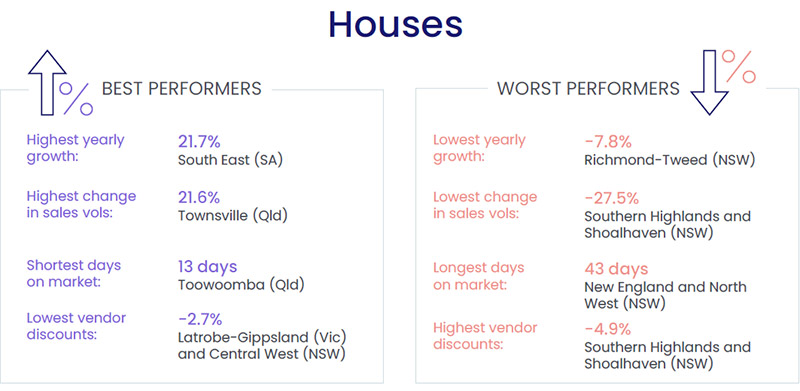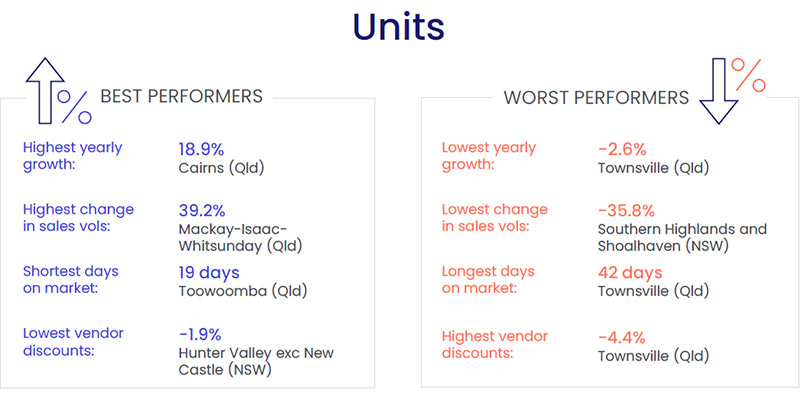Regional property prices nosediving fast
The meteoric regional real estate price rises that were a feature of the Covid years are now unravelling at a similar rate of knots.
Almost 90 per cent of Australia’s regional property markets have had property price falls over the past three months.
Across Australia’s largest 25 non-capital city regions, 21 recorded an increase in house values over the year to October 2022, down from 25 over the year to July.
The South East region in South Australia was the best performing regional house market, with an annual value growth of 21.7 per cent, followed by the New South Wales regions of Riverina and New England and North West, up 20.5 per cent and 19.8 per cent respectively. The lowest yearly growth rate was recorded across the Richmond-Tweed (-7.8 per cent) and Illawarra (-1.9 per cent) regions in New South Wales, with values falling below the levels recorded this time last year.
CoreLogic Economist Kaytlin Ezzy said value declines initially seen across the more expensive capital city and regional markets have become more geographically broad-based over the three months to October, with 87.8 per cent of the regional house and unit markets analysed recording a quarterly decline in values.
“Consecutive interest rate rises, persistently high inflation, and waning consumer sentiment saw the pace of value declines accelerate across regional Australian property markets,” Ms Ezzy said.
“It is unsurprising the Richmond-Tweed region recorded the strongest decline in house values.
“Throughout the COVID period, values skyrocketed, rising more than 50 per cent and taking the median house value to more than $1.1 million, however, the impact of this year’s floods, coupled with seven consecutive rate rises, has seen house values fall in the region by nearly 16 per cent since April.”
Queensland’s sliver of light
Central Queensland was the only region that saw an increase in house values over the quarter, albeit a small one (0.1 per cent), while the remaining two regions held steady over the quarter (South East, SA and Bunbury, WA). The Richmond-Tweed region (NSW) recorded the largest quarterly fall, down 11.7 per cent, followed by the Southern Highlands and Shoalhaven (NSW) and Sunshine Coast (Qld), where house values declined by 7.1 per cent across both regions.
The top three regions with the largest increase in sales volumes over the 12 months to August were all located in Queensland. Annual house sales across Townsville were up 21.6 per cent, while sales activity across Central Queensland and Mackay - Isaac - Whitsunday rose by 18.6 per cent and 12.5 per cent respectively.
At the other end of the scale, the number of regions recording a decline in annual sales activity increased, from 15 over the 12 months to May, to 19 over the 12 months to August. The Southern Highlands and Shoalhaven region in NSW recorded the largest fall (-27.5 per cent), followed by Richmond - Tweed, NSW (-26.5 per cent), Latrobe-Gippsland, Vic (-24.5 per cent) and the Sunshine Coast, Qld (-21.4 per cent).

Source: CoreLogic Regional Market Update.
Houses sold fastest in Toowoomba (Qld) where the median time on market over the year to October was 13 days, down from 17 days over the previous 12 months. Tasmania’s Launceston and North East region recorded the second fastest sales time, with a median time on market of 19 days, up from 13 days over the previous 12-month period.
The slowest selling house region was once again the New England and North West region in NSW, where houses were taking 43 days to sell on average over the 12 months to October 2022, an improvement from the 61 days it took to sell a house in the year to October 2021.
Vendors in the Central West (NSW) and Latrobe-Gippsland (Vic) regions are offering the smallest discounts to secure a sale with a median discount rate of -2.7 per cent, while the largest discounts are being offered across the Southern Highlands and Shoalhaven region (-4.9 per cent).
Units taken turn for worse
While all but two of the 16 regions analysed saw an annual increase in unit values, 14 saw a quarterly fall, more than double the number of regions that declined in values over the three months to July.
“While unit values have not been immune to the downturn, units have largely been more resilient than houses through the downswing to date,” Ms Ezzy said.
If this trend of house values falling at a faster pace than unit values persists, we could see some demand shift towards the detached segment as the value premium for houses shrinks.”
Across Australia’s regional unit markets, Queensland’s Cairns and Toowoomba regions recorded the highest annual increase in values over the 12 months to October 2022, up 18.9 per cent and 17.4 per cent respectively.
We could see an increasing number of regional homeowners come up against affordability pressures in terms of mortgage serviceability.
- Kaytlin Ezzy, Economist, CoreLogic
At the other end of the scale, Townsville (Qld) and Richmond-Tweed (NSW) were the only regions to record a decline in unit values over the past year, down -2.6 per cent and -0.2 per cent respectively.
Southern Highlands and Shoalhaven, NSW (-7.7 per cent) recorded the largest quarterly fall in unit values, followed by Queensland’s Sunshine Coast, where unit values declined 6.0 per cent over the three months to October.
Sales volumes down
Only five regions saw an increase in the volume of unit sales over the year to August, with all five located in Queensland. Annual unit sales increased by 39.2 per cent across Mackay – Isaac - Whitsunday, 24.5 per cent across Townsville, 19.5 per cent across Toowoomba, 16.6 per cent across Cairns and 11.3 per cent across Central Queensland.
In contrast, 20 regions saw sales volumes fall over the year to August, with four of the five largest declines recorded across NSW. Southern Highlands and Shoalhaven (-35.8 per cent), Newcastle and Lake Macquarie (-30.9 per cent), Illawarra (-26.4 per cent) and Richmond-Tweed (-26.2 per cent), all in New South Wales, recorded the largest year-on-year declines, followed by Victoria’s Ballarat region (-24.4 per cent).

Source: CoreLogic Regional Market Update.
Units across Queensland’s Toowoomba region are currently selling quicker than any other region with a median time on market of 19 days over the year to October 2022, followed by the Gold Coast, (20 days), Ballarat (21 days) and Cairns (21 days).
Townsville in Queensland and the Capital region in NSW were the slowest selling unit regions, with a median time on market of 42 days and 41 days respectively. Vendors in Townville are offering the largest discounts in order to secure a sale (-4.4 per cent) while discounts of 1.9 per cent in the Hunter Valley (excluding Newcastle) region (NSW) are the lowest amongst the unit markets analysed.
Regional outlook
Properties are now sitting on the market for around two to three days longer than they were over the year to July, demonstrating a continued softening in demand.
“Sales activity has continued to soften over the quarter, with only a few regions, predominantly in northern Queensland, recording an increase in annual sales volumes,” Ms Ezzy said.
“While down compared to the previous year, it’s important to remember that last year was one of the busiest sales periods on record, and the majority (76 per cent) of regional markets analysed are still recording higher annual sales volumes compared to their previous five-year averages,” she said.
On the supply side, the flow of regional listings has been relatively lacklustre this spring selling season, which has kept total listings levels fairly tight, despite a slowdown in sales activity.
“While the negotiating power across Australian regional markets is slowly transitioning to the buyer, it is likely tight supply is insulating the downturn to some extent,” she said.
Ms Ezzy added the outlook for Australia's regional markets remains skewed to the negative, with values expected to continue declining while interest rates are rising.
“The lack of a typical spring listings surge is positive, in that we are yet to see material signs of a rise in distressed listings, however, as the cumulative rise in the cash rate approaches the serviceability buffer of 3 per cent that most borrowers were assessed under, we could see an increasing number of regional homeowners come up against affordability pressures in terms of mortgage serviceability.”


















